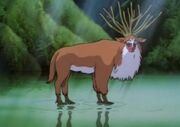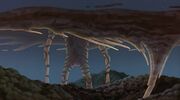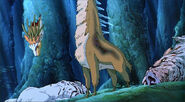Forest Spirit, also called Shishigami (シシ神, lit. Deer God) and Night-Walker (デイダラボッチ, Deidarabotchi), is a supporting character in Princess Mononoke. It is known as a god of life and death.
Appearance[]
The Forest Spirit looks like deer, but with plant-like antlers and a human-like face.[1]
It can transform into a gigantic, translucent humanoid during the night called the Night-Walker.
Story[]
The Deer God "Forest Spirit" is the protector of the Cedar Forest and is the god of life and death. It heals Ashitaka of his bullet wound, yet interestingly leaves the boar's curse untouched. Later, it mercy-kills Okkoto and Moro by taking their life. During Lady Eboshi's hunt to kill the Deer God, she shoots it as it transforms, turning it into the humanoid-like Night-Walker, releasing its destructive body. This causes the life of everything it touches to be drained away, causing mass destruction and death; this lasts until Ashitaka and San return its head, restoring peace.
Abilities[]

The Forest Spirit standing on water.

The Night-Walker is searching for its head.
- Immortality and invulnerability. The emperor Mikado believes it is possible to become immortal by eating his head. But Eboshi proves that the Night-Walker is vulnerable by shooting off his head while Forest Spirit has no visible damage when it was shot at the neck.
- Reincarnation. It is implied that Forest Spirit repeatedly dies and reincarnates especially on new moons and full moons.
- Powers over life. His blood cures all illness and curses, which can be seen at the end of the movie. When it touches the ground, the plants under his feet grow in a quick spurt and wither away quickly. It can heal wounds by touching them with his mouth, though it, either intentionally or unintentionally, didn't take away Ashitaka's curse that way. It can also grow plants at supernatural growth speed among vast ranges. It also cultivates the forest as Night-Walker during nights. Ashitaka and Kohroku's health conditions slightly improved when they encountered Forest Spirit for the first time. At the end of the film, its power was infused with winds, growing plants over vast ranges and cured Ashitaka's curse and leprosy patients.
- Powers over death. It can end life simply by touching or breathing on the targets. Demons don't fear anybody, besides the Forest Spirit. It takes Okkoto's life, who became a demon as a result. Kohroku believed he would die if it looked into the Forest Spirit's eyes, though this is just an unprecedented speculation. The fluid from Forest Spirit's head caused cursed marks on humans who touched it.
- Walking over water. Forest Spirit can walk over water surfaces. Body parts and blobs of Night-Walker also don't sink in the water.
- Night-Walker. At the Sea of the Forest Spirit, it transforms into the Night-Walker at midnight to collect souls of organizms and to cultivate the forest. If it loses his head, it becomes a deathly threat.
Mythology[]
In Japanese mythology, it is called Yatsukamizuomitsuno,[2] who is worshipped in Nagahama, Shiga. His origin is from buddhism script The Kasuga Deer Mandala, where it is seen as a deer with a tree on his head.[3] It is the power that forms a planet.[4]
The Night-Walker is called Daidarabotchi in Japanese. In the movie, the deer-like Forest Spirit and the Night-Walker are the personifications of the Forest. They are neither good nor evil.
Trivia[]
- There was a species of front-eyed goat called Myotragus, which somewhat resembles the face of Forest Spirit.
- According to Hayao Miyazaki, Forest Spirit is a "low-classed" god.[5]
- Shishigami and Deidarabotchi's designs were likely based on the man-faced beast and the giant appeared in Daijiro Moroboshi's Koshi Ankokuden and Mud Men where Miyazaki deeply respects his works; San's outfit was also based on those seen in Mud Men.
- According to Hayao Miyazaki, designs of Shishigami's eyes are inspired by that of Falkor from The Neverending Story.
- While Eboshi forged irons with tatara to defeat Forest Spirit, Daidarabottchi in folklore is associated with tatara (the term tatara was delivered from Daidarabottchi).
- Ironically, both Forest Spirit and Eboshi bear some similarities in their actions; both conducted "God Slaying" (神殺し, kami-goroshi) and killed countless animals and plants and mononoke and humans, and destroyed the Cedar Forest.
- Ironically, Deidarabotchi and Kodama, the children of trees, resemble humans in general appearances.
- Forest Spirit and River Spirit share several similarities including being man-faced animal-like deities of respective environments, going through drastic transformation, and providing indirect helps on protagonists, and so on.
- Lady Eboshi believed that killing the god would turn the wolf and boar gods into mindless animals. Okkoto also stated that with the forest (which the god represents) weakening, his tribe were growing "stupid" and would be reduced to "squealing game". This would imply that the Great Forest Spirit was somewhat responsible for the animal gods salience, directly or not. However, San's wolf brothers remained as they were even after his (supposed) death, though Ashitaka suggests that he is still alive in another form.
Gallery[]
References[]
- ↑ The Art of The Princess Mononoke
- ↑ [eos.kokugakuin.ac.jp/modules/xwords/entry.php?entryID=1304 Daisen Shinkou] (jap.), retrieved december 1st, 2013
- ↑ Kasuga Deer Mandala, 14. Jhd., Nara National Museum, rtrieved november 26th, 2012
- ↑ Hayao Miyazaki: Recovery of Japanese Cultural Values (eng.), Autor: Aurora van Zoelen, retrieved december 13rd, 2012
- ↑ Hayao Miyazaki, 2008, Turning Point: 1997-2008
[]
| Princess Mononoke | |
|---|---|
| Characters | |
| Emishi Village | Ashitaka | Kaya | Ji | Hī-sama | Yakul |
| Irontown Denizens | Lady Eboshi | Gonza | Irontown Guard | Kiyo | Kohroku | Toki | Osa |
| Mononoke | San | Forest Spirit/Shishigami | Moro | Moro's clan | Apes | Kodama | Nago | Okkoto | Boar clan |
| Others | Jigo/Jikobo | Demon | Asano |
| Miscellaneous | |
| Locations | Cedar Forest | Irontown | Emishi Village |
| Objects | Crystal dagger |
| Music | Soundtrack | Ashitaka and San | The Legend of Ashitaka |




